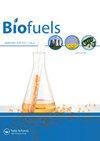Synthesis of Sn-CaO as a bifunctional catalyst and its application for biodiesel production from waste cooking oil
IF 2.6
4区 工程技术
Q3 ENERGY & FUELS
引用次数: 3
Abstract
Abstract Herein, a simple solid-state method was employed to synthesize a bifunctional tin (Sn) supported calcium oxide (CaO) catalyst. The synthesized catalyst (Sn-CaO) was found to be suitable for the conversion of waste cooking oil to biodiesel in a single-step reaction procedure. To achieve maximum conversion, the physicochemical and surface morphological characteristics of the catalyst were investigated using FTIR, XRD and FESEM-EDX. Box-Behnken Design based on Response Surface Methodology was used to optimize biodiesel conversion. At optimized conditions, the variables affecting the reaction were, methanol to oil molar ratio (16.15:1), time (3.42 h), temperature (85.15 °C) and catalyst concentration (2.22% with respect to oil) that led to biodiesel conversion amounting to 97.39%. Three experiments were carried out under these conditions to validate the predicted model. The experimental value of biodiesel conversion in this setting was 96.72 ± 0.61%. The acid value and kinematic viscosity of biodiesel were measured at 40 °C and were determined to be 0.48 mg KOH g−1 and 5.3 mm2 s−1, respectively, fulfilling the ASTM and EN standards. The simultaneous esterification and transesterification reaction mechanism were also described. The finding of this study leads to an economical and environmentally benign approach to biodiesel production. Graphical Abstract双功能催化剂Sn-CaO的合成及其在废食用油生产生物柴油中的应用
摘要:本文采用简单的固态方法合成了一种双功能锡负载氧化钙催化剂。所合成的催化剂(Sn-CaO)适合于在一步反应过程中将废食用油转化为生物柴油。为了实现最大的转化率,利用FTIR、XRD和FESEM-EDX对催化剂的物理化学和表面形态特征进行了研究。基于响应面法的Box-Behnken设计优化了生物柴油的转化。在优化条件下,甲醇与油的摩尔比(16.15:1)、时间(3.42 h)、温度(85.15℃)和催化剂浓度(油比2.22%)对反应的影响最大,生物柴油转化率为97.39%。在此条件下进行了三次实验来验证预测模型。该条件下生物柴油转化率的实验值为96.72±0.61%。在40℃下测定生物柴油的酸值和运动粘度,分别为0.48 mg KOH g−1和5.3 mm2 s−1,符合ASTM和EN标准。同时描述了酯化反应和酯交换反应机理。这项研究的发现为生物柴油的生产提供了一种既经济又环保的方法。图形抽象
本文章由计算机程序翻译,如有差异,请以英文原文为准。
求助全文
约1分钟内获得全文
求助全文
来源期刊

Biofuels-Uk
Energy-Renewable Energy, Sustainability and the Environment
CiteScore
5.40
自引率
9.50%
发文量
56
期刊介绍:
Current energy systems need a vast transformation to meet the key demands of the 21st century: reduced environmental impact, economic viability and efficiency. An essential part of this energy revolution is bioenergy.
The movement towards widespread implementation of first generation biofuels is still in its infancy, requiring continued evaluation and improvement to be fully realised. Problems with current bioenergy strategies, for example competition over land use for food crops, do not yet have satisfactory solutions. The second generation of biofuels, based around cellulosic ethanol, are now in development and are opening up new possibilities for future energy generation. Recent advances in genetics have pioneered research into designer fuels and sources such as algae have been revealed as untapped bioenergy resources.
As global energy requirements change and grow, it is crucial that all aspects of the bioenergy production process are streamlined and improved, from the design of more efficient biorefineries to research into biohydrogen as an energy carrier. Current energy infrastructures need to be adapted and changed to fulfil the promises of biomass for power generation.
Biofuels provides a forum for all stakeholders in the bioenergy sector, featuring review articles, original research, commentaries, news, research and development spotlights, interviews with key opinion leaders and much more, with a view to establishing an international community of bioenergy communication.
As biofuel research continues at an unprecedented rate, the development of new feedstocks and improvements in bioenergy production processes provide the key to the transformation of biomass into a global energy resource. With the twin threats of climate change and depleted fossil fuel reserves looming, it is vitally important that research communities are mobilized to fully realize the potential of bioenergy.
 求助内容:
求助内容: 应助结果提醒方式:
应助结果提醒方式:


